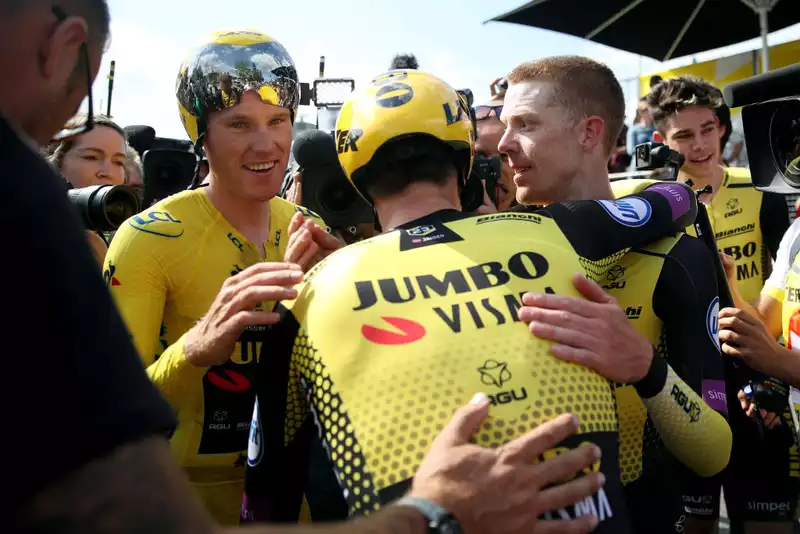Richard Plagge, team manager of Jumbo Visma, argued in a Dutch newspaper that professional riders should have "team numbers" on their jerseys, like soccer players. Team Ineos riders have their last names printed on them. Is it finally time to replace the paper race numbers distributed at each competition with something a little more permanent?
"Commentators receive a different list of cyclist names for each race," Plug noted this week to the Algemeen Dagblad in a lengthy interview about bib numbers. 'One week it's numbers 1 through 8, the next week it's numbers 31 through 38. The commentators have to keep looking for who is who. As for Chris Froome and Peter Sagan, it's not that difficult, but some of the players are very hard to figure out.
"Currently, each team leader's number usually ends with a '1' and the rest of the team numbers end with an '8'. Sometimes the race organizer determines the remaining numbers, sometimes the teams do.
"Bib number 1 is the team of the winner of the previous year's race, as in the Tour de France. But sometimes the winner from a year ago has moved to another team and runs at number 18 or 41," says Plug.
In the past, some have pushed for a season numbering system, with all riders having different numbers based on their UCI ranking at the end of the season, while others have suggested team numbers within each team, like soccer teams. [For example, everyone can tell the difference between our jerseys and the Ineos jerseys. Ineos would put number 1 on Froome and Egan Bernal, and we would put number 1 on Primoz Roglic," Plug told AD.nl.
Jumbo Visma has already had its own individual team number for some years; Roglic is indeed number 1. Tom Dumoulin is number 6, Steven Kruijswijk is number 8, and team sprinter Dylan Groenewegen is number 14. In addition, Aeroload helmets often have the Christian names of the athletes printed on them.
The Italian Mapei team started in the mid-1990s, and Team Ineos started as Team Sky in 2010, and from the beginning the jerseys had the players' last names printed on them.
"We adopted fixed numbers a while ago and the riders wear the numbers they wore when they joined the team," explained Plug.
In the 2015 Tour de France, the team, which normally wears yellow, wore a special white and yellow jersey to distinguish it from the leader's yellow jersey. The team's main sponsor was the Dutch national lottery LottoNL, and the riders had personalized lottery balls printed on their jerseys.
Additionally, last year they were printed on the back of the neck, and this season on the back pockets where bib numbers are usually hidden.
"People tend to think it represents a ranking within the team, but it doesn't. 'When we asked riders which number they preferred, there was little overlap. Riders would pick their lucky number or the number of the day they got married."
[22"Dylan Groenewegen is from Amsterdam, so he is number 14. It is a reference to the fact that Johan Cruyff, the most famous Dutch soccer player, was born in Amsterdam and played most of his career for the Amsterdam club Ajax, where he mainly wore the number 14 shirt.
The idea of having permanent numbers rather than the rudimentary paper numbers distributed at each race, as in soccer and other sports, tends to surface every few years but has so far been resisted by the governing body, the UCI.
A further complication is the fact that bib numbers often have sponsors printed on them, and if permanent numbers were printed on jerseys, organizers would lose a source of revenue.
"From a sporting perspective, I am quite surprised that bib numbers are still in use. Bib numbers are still used in athletics, and in the 100-meter sprint, where hundredths of a second is at stake, you can see the numbers fluttering behind the athletes like parachutes."
"Cyclists often have to pin their numbers on, and when the safety pin comes off, the numbers start flapping, which is terrible for performance [aerodynamically]."
Thus, printed numbers on jerseys would put an end to the traditional flying numbers.
"Cycling has changed dramatically throughout history, and today's bib numbers are outdated. With all riders having timing chips on their bikes, frame numbers for photo finishes are no longer necessary," said Plug, reiterating that while the sport has moved forward in some respects, this is not the case with bib numbers.
.

Comments